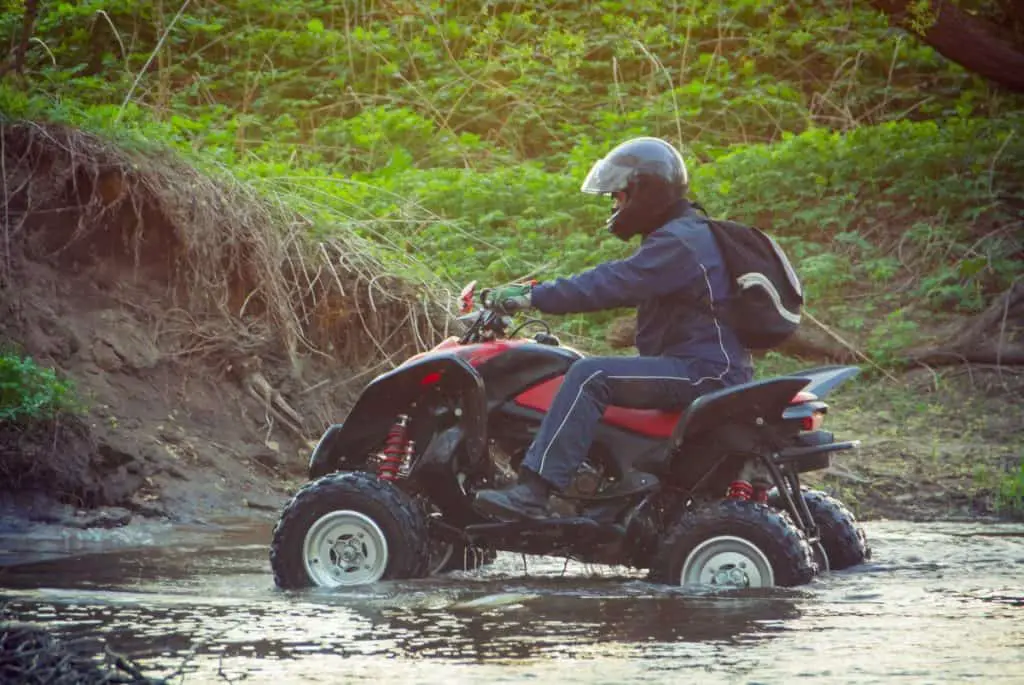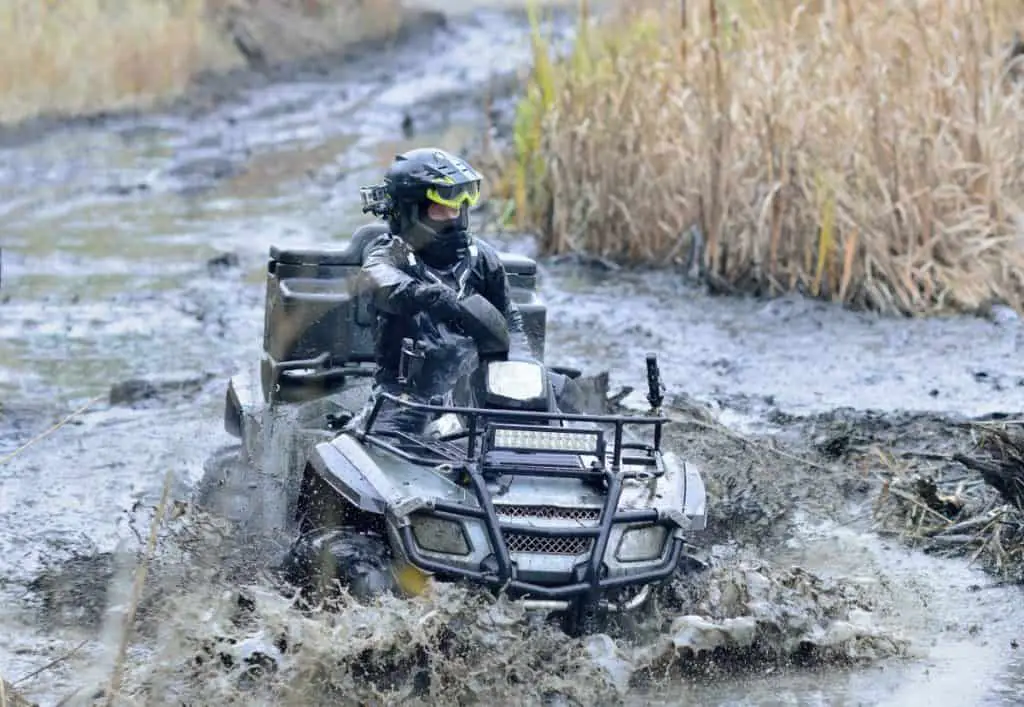I’ve been riding quads in a range of conditions, and when I first got my quad I wanted to know if it can go in water, and if so how deep can the water be?
I looked at the manufacturer’s recommendations for my quad, and whether there is a type of quad that is better suited to going in the water, and here’s what I found.
As a general rule, you can ride a quad in up to 14 inches (35 cm) of slow-moving water. Care needs to be taken when entering the water to avoid sharp drop-offs and obstacles such as rocks and tree branches. Take some time before riding through water to plan the safest path to take.
You want to aim for the flattest, smoothest path. However, water in streams and puddles isn’t always clear to where you can see what’s under the water.
Certain ATVs can be specially designed to go through deeper water, so below I will explain some tips for riding a quad in water, as well as whether you can ride an ATV, and a four wheeler through water.

How to ride a Quad in water
Riding quads through water is quite fun, although sometimes it can feel a little bit unsafe especially when you lose traction. There are a few tips to keep in mind when riding a quad through water. They are:
1. Squeeze the brakes after exiting the water
The brakes of a quad will be completely drenched in water when you ride through water. The water makes the brakes more lubricated, and your initial attempt at braking can take longer than normal until the water is gone.
Squeeze the brakes a few times to test they are working as normal once you exit the water.
2. Never exceed 4 miles per hour (6.5 km per hour)
The recommendation from driving instructors is that you should drive through water at a maximum speed of 4 mph (6.5 km/h). You should also enter the water at a slower speed of 1 to 2 mph (2 to 3 km/h).
This is also the case for riding through water on roads.

3. Give way to other vehicles
In certain situations, you can be driving your quad where there are other quads, dirt bikes, bicycles, and cars. For example, on a country road, you can be driving in the opposite direction to another car or dirt bike.
In cases where you need to ride through water where there are other vehicles around, it’s best to practice caution, and give way to other vehicles. It’s not advisable to attempt any passing maneuvers, or get close to other vehicles when riding through water.
Not only can you get a big splash as they drive past, but the grip of the tires isn’t as good, and it’s more difficult to drive accurately.
4. Avoid water where possible
Overall, it’s best to avoid riding through water when you have the option. Hard, dry ground is always preferred as it provides the most grip. As a result, it’s easier to steer, and you don’t risk getting stuck.
In some cases riding through water can make your quad dirtier. For example, if you ride through a muddy body of water. Other times, when the water is very clear it can clean the bottom of your ATV.
Regardless of how clean or muddy the water is, your first option should be to go around terrain and roads that have standing or flowing water.
Can you ride an ATV in Water?
ATV is a broad term that refers to vehicles that are designed to go on terrain that cars and motorcycles find very difficult to drive on.
ATV stands for ‘all terrain vehicle’. A quad is a type of ATV. But, in practice, an ATV and a quad are the exact same thing. So, the same rules that apply to a quad also apply to an ATV.
Therefore, you should be cautious about riding an ATV in water and don’t drive an ATV through water that is deeper than 14 inches (35 cm). The tips for riding a quad through water above equally apply to riding an ATV in water.

Can You Ride a Four Wheeler in Water?
Four wheelers are fun to ride, and I love driving them on trails but often I’d come across puddles, or parts of roads and trails that have running water. So, I wanted to know whether riding a four wheeler in water is OK. Here’s what I found.
Generally, it’s fine to ride a four wheeler in water provided the water does not exceed a depth of 14 inches (35 cm). It’s recommended that you drive slower than 4 mph (6.5 km/h), and to avoid riding through flowing water. Where possible avoid riding a four wheeler through water.
A four wheeler, an ATV, and a quad are all names for the same vehicle. So, the same guidelines about riding each of them through water apply.
How to prevent your quad from getting stuck
You should always pause to assess the situation when you get stuck. Often, trying to accelerate can force your quad deeper into the mud. So, I thought I’d share some tips about preventing your quad from getting stuck, and what to do if it does get stuck.
You can attempt shifting your bodyweight towards the front or the back of your quad to get more traction on one area of your quad. If you can’t drive out of a hole, the best solution is almost always to use a winch.
Some ATVs can come with a winch. But, if you know you will be regularly riding your ATV in conditions where it can get stuck it’s best to invest in a winch. Most winches cost around $300 but they more than make up for it since you won’t have the hassle of getting another vehicle to pull you out.

